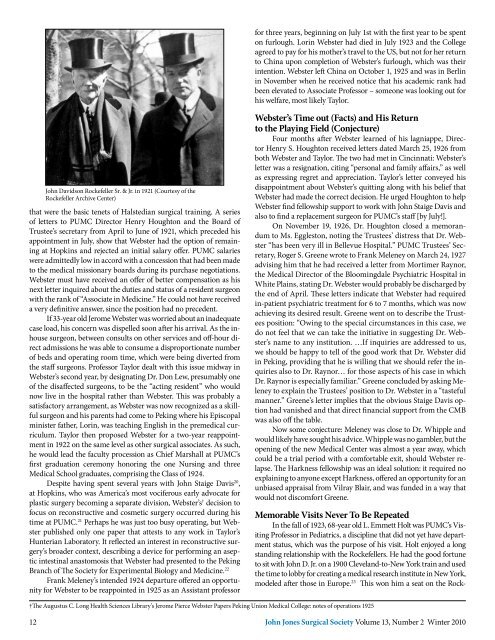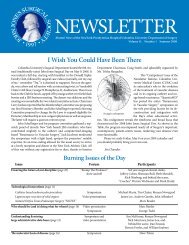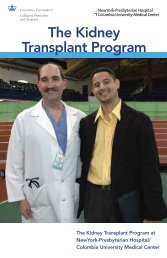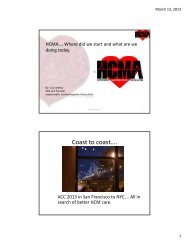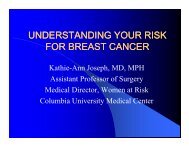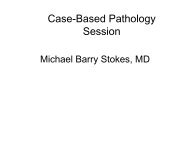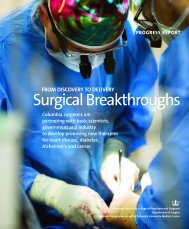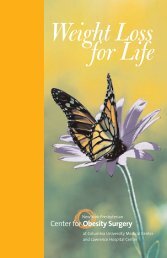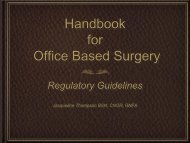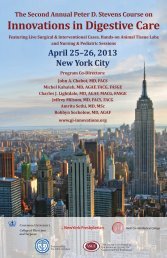NEWSLETTER - Columbia University Department of Surgery
NEWSLETTER - Columbia University Department of Surgery
NEWSLETTER - Columbia University Department of Surgery
Create successful ePaper yourself
Turn your PDF publications into a flip-book with our unique Google optimized e-Paper software.
John Davidson Rockefeller Sr. & Jr. in 1921 (Courtesy <strong>of</strong> the<br />
Rockefeller Archive Center)<br />
that were the basic tenets <strong>of</strong> Halstedian surgical training. A series<br />
<strong>of</strong> letters to PUMC Director Henry Houghton and the Board <strong>of</strong><br />
Trustee’s secretary from April to June <strong>of</strong> 1921, which preceded his<br />
appointment in July, show that Webster had the option <strong>of</strong> remaining<br />
at Hopkins and rejected an initial salary <strong>of</strong>fer. PUMC salaries<br />
were admittedly low in accord with a concession that had been made<br />
to the medical missionary boards during its purchase negotiations.<br />
Webster must have received an <strong>of</strong>fer <strong>of</strong> better compensation as his<br />
next letter inquired about the duties and status <strong>of</strong> a resident surgeon<br />
with the rank <strong>of</strong> “Associate in Medicine.” He could not have received<br />
a very definitive answer, since the position had no precedent.<br />
If 33-year old Jerome Webster was worried about an inadequate<br />
case load, his concern was dispelled soon after his arrival. As the inhouse<br />
surgeon, between consults on other services and <strong>of</strong>f-hour direct<br />
admissions he was able to consume a disproportionate number<br />
<strong>of</strong> beds and operating room time, which were being diverted from<br />
the staff surgeons. Pr<strong>of</strong>essor Taylor dealt with this issue midway in<br />
Webster’s second year, by designating Dr. Don Lew, presumably one<br />
<strong>of</strong> the disaffected surgeons, to be the “acting resident” who would<br />
now live in the hospital rather than Webster. This was probably a<br />
satisfactory arrangement, as Webster was now recognized as a skillful<br />
surgeon and his parents had come to Peking where his Episcopal<br />
minister father, Lorin, was teaching English in the premedical curriculum.<br />
Taylor then proposed Webster for a two-year reappointment<br />
in 1922 on the same level as other surgical associates. As such,<br />
he would lead the faculty procession as Chief Marshall at PUMC’s<br />
first graduation ceremony honoring the one Nursing and three<br />
Medical School graduates, comprising the Class <strong>of</strong> 1924.<br />
Despite having spent several years with John Staige Davis 20 ,<br />
at Hopkins, who was America’s most vociferous early advocate for<br />
plastic surgery becoming a separate division, Webster’s † decision to<br />
focus on reconstructive and cosmetic surgery occurred during his<br />
time at PUMC. 21 Perhaps he was just too busy operating, but Webster<br />
published only one paper that attests to any work in Taylor’s<br />
Hunterian Laboratory. It reflected an interest in reconstructive surgery’s<br />
broader context, describing a device for performing an aseptic<br />
intestinal anastomosis that Webster had presented to the Peking<br />
Branch <strong>of</strong> The Society for Experimental Biology and Medicine. 22<br />
Frank Meleney’s intended 1924 departure <strong>of</strong>fered an opportunity<br />
for Webster to be reappointed in 1925 as an Assistant pr<strong>of</strong>essor<br />
for three years, beginning on July 1st with the first year to be spent<br />
on furlough. Lorin Webster had died in July 1923 and the College<br />
agreed to pay for his mother’s travel to the US, but not for her return<br />
to China upon completion <strong>of</strong> Webster’s furlough, which was their<br />
intention. Webster left China on October 1, 1925 and was in Berlin<br />
in November when he received notice that his academic rank had<br />
been elevated to Associate Pr<strong>of</strong>essor – someone was looking out for<br />
his welfare, most likely Taylor.<br />
Webster’s Time out (Facts) and His Return<br />
to the Playing Field (Conjecture)<br />
Four months after Webster learned <strong>of</strong> his lagniappe, Director<br />
Henry S. Houghton received letters dated March 25, 1926 from<br />
both Webster and Taylor. The two had met in Cincinnati: Webster’s<br />
letter was a resignation, citing “personal and family affairs,” as well<br />
as expressing regret and appreciation. Taylor’s letter conveyed his<br />
disappointment about Webster’s quitting along with his belief that<br />
Webster had made the correct decision. He urged Houghton to help<br />
Webster find fellowship support to work with John Staige Davis and<br />
also to find a replacement surgeon for PUMC’s staff [by July!].<br />
On November 19, 1926, Dr. Houghton closed a memorandum<br />
to Ms. Eggleston, noting the Trustees’ distress that Dr. Webster<br />
“has been very ill in Bellevue Hospital.” PUMC Trustees’ Secretary,<br />
Roger S. Greene wrote to Frank Meleney on March 24, 1927<br />
advising him that he had received a letter from Mortimer Raynor,<br />
the Medical Director <strong>of</strong> the Bloomingdale Psychiatric Hospital in<br />
White Plains, stating Dr. Webster would probably be discharged by<br />
the end <strong>of</strong> April. These letters indicate that Webster had required<br />
in-patient psychiatric treatment for 6 to 7 months, which was now<br />
achieving its desired result. Greene went on to describe the Trustees<br />
position: “Owing to the special circumstances in this case, we<br />
do not feel that we can take the initiative in suggesting Dr. Webster’s<br />
name to any institution. …If inquiries are addressed to us,<br />
we should be happy to tell <strong>of</strong> the good work that Dr. Webster did<br />
in Peking, providing that he is willing that we should refer the inquiries<br />
also to Dr. Raynor… for those aspects <strong>of</strong> his case in which<br />
Dr. Raynor is especially familiar.” Greene concluded by asking Meleney<br />
to explain the Trustees’ position to Dr. Webster in a “tasteful<br />
manner.” Greene’s letter implies that the obvious Staige Davis option<br />
had vanished and that direct financial support from the CMB<br />
was also <strong>of</strong>f the table.<br />
Now some conjecture: Meleney was close to Dr. Whipple and<br />
would likely have sought his advice. Whipple was no gambler, but the<br />
opening <strong>of</strong> the new Medical Center was almost a year away, which<br />
could be a trial period with a comfortable exit, should Webster relapse.<br />
The Harkness fellowship was an ideal solution: it required no<br />
explaining to anyone except Harkness, <strong>of</strong>fered an opportunity for an<br />
unbiased appraisal from Vilray Blair, and was funded in a way that<br />
would not discomfort Greene.<br />
Memorable Visits Never To Be Repeated<br />
In the fall <strong>of</strong> 1923, 68-year old L. Emmett Holt was PUMC’s Visiting<br />
Pr<strong>of</strong>essor in Pediatrics, a discipline that did not yet have department<br />
status, which was the purpose <strong>of</strong> his visit. Holt enjoyed a long<br />
standing relationship with the Rockefellers. He had the good fortune<br />
to sit with John D. Jr. on a 1900 Cleveland-to-New York train and used<br />
the time to lobby for creating a medical research institute in New York,<br />
modeled after those in Europe. 23 This won him a seat on the Rock-<br />
†The Augustus C. Long Health Sciences Library’s Jerome Pierce Webster Papers Peking Union Medical College: notes <strong>of</strong> operations 1925<br />
12 John Jones Surgical Society Volume 13, Number 2 Winter 2010


